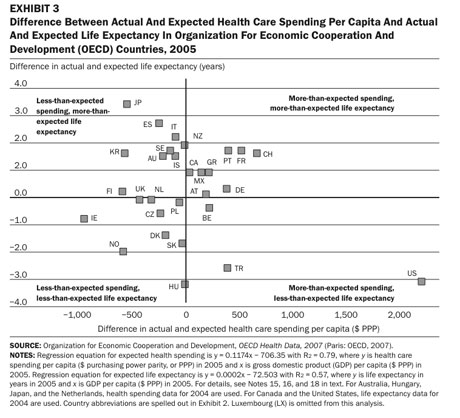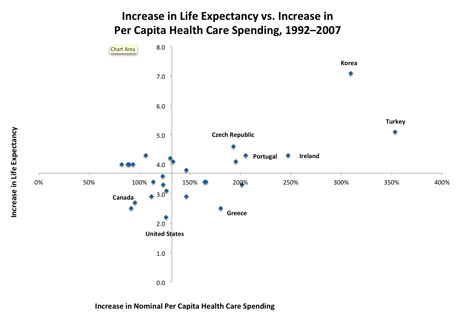
I was looking at OECD health care data for something else I’ve been working on and wanted to share some of it. It’s well known that the United States spends a lot more per person on health care than comparable countries and that our actual health outcomes are anywhere from average to bad. See, for example, this chart from a 2008 paper by Gerard Anderson and Bianca Frogner.
That chart shows how each country’s spending and life expectancy differ from what you would expect based solely on how rich they are (per capita GDP). As you can see, we spend a lot more and live a lot less. (That paper also considers a number of other outcome measures; we do well on some, poorly on others.)
Besides where we are today, though, the other thing we should be interested in is where we are going. Our health care system is the product of a number of historical factors that we can’t make go away with a snap of our fingers. So even if we have a bad, expensive health care system, maybe it is getting relatively better and relatively less expensive.
Nope.
This chart, from the OECD data, shows the change in each country’s per capita spending and life expectancy relative to all other countries. The data are standardized: you’re looking at the number of standard deviations each country was away from the mean in 1992 and in 2007.*
You can see that not only is the United States the outlier when it comes to spending, but we are moving in the wrong direction: we are becoming more of a spending outlier, and we are drifting down from the average life expectancy into the lower group (currently surpassing only Turkey, Hungary, Mexico, Poland, and Czech Republic).
I labeled a few of the other outliers. Basically the lower left is relatively poor countries, Japan is at the top, and that big cluster is Western Europe and the Commonwealth countries.
Another way to look at the situation is to look at actual values rather than standard deviations, as in the following chart. This one shows you actual increases in life expectancy and percentage increases in nominal per capita health care spending. The axes are located at the averages of these countries: the average spending increase was 132 percent and the average life expectancy gain was 3.7 years.
One thing you can see is that, in percentage terms, health care costs have not been growing in the United States much faster than in other comparable countries.** If you exclude countries starting with a small 1992 base (Korea, Turkey, Ireland, etc.), our rate of health care cost growth has been above average, but it’s not an outlier. So the reasons why our health care costs are growing rapidly are probably at least somewhat different from the reasons why they are high to begin with.
The other thing you see is that our life expectancy gain was the absolute lowest of the whole group (and we weren’t starting from a particularly high level, as you can see in the previous chart).
Ordinarily, you would think there should be convergence across countries. Since other countries spend less and live longer, you would think that we would learn from them—global competition, you know. But instead we’re moving the wrong way on both dimensions.
* I picked all OECD countries for which there was data, except Belgium (which has a different methodology for counting spending), which meant dropping Chile, Estonia, Israel, Luxembourg, Slovak Republic, and Slovenia. I only went back to 1992 because Germany has a gap in 1991 and I initially planned to use all the intervening years. I stopped in 2007 because Canada and Greece are missing data for later years.
** We had below-average growth in percentage terms, yet the number of standard deviations separating us from the mean increased, because the poorer countries increased spending rapidly; this convergence caused the standard deviation to fall as a proportion of the mean.
Angry, shocked, overwhelmed? Take action: Support independent media.
We’ve borne witness to a chaotic first few months in Trump’s presidency.
Over the last months, each executive order has delivered shock and bewilderment — a core part of a strategy to make the right-wing turn feel inevitable and overwhelming. But, as organizer Sandra Avalos implored us to remember in Truthout last November, “Together, we are more powerful than Trump.”
Indeed, the Trump administration is pushing through executive orders, but — as we’ve reported at Truthout — many are in legal limbo and face court challenges from unions and civil rights groups. Efforts to quash anti-racist teaching and DEI programs are stalled by education faculty, staff, and students refusing to comply. And communities across the country are coming together to raise the alarm on ICE raids, inform neighbors of their civil rights, and protect each other in moving shows of solidarity.
It will be a long fight ahead. And as nonprofit movement media, Truthout plans to be there documenting and uplifting resistance.
As we undertake this life-sustaining work, we appeal for your support. Please, if you find value in what we do, join our community of sustainers by making a monthly or one-time gift.


